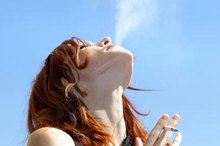Smoking & the Cilia
Smoking is still the leading preventable cause of death in the United States, but relatively minor health problems associated with tobacco use are often overlooked in favor of more life-threatening diseases, such as lung cancer. The cilia are small projections in the lungs which act as a filter, and smoking harms their functioning in a significant way. This can lead to a number of more serious smoking-related conditions. It is important to consider these conditions in addition to the more well-known diseases when discussing the impact of smoking on health.
What are Cilia?
The cilia are microscopic hair-like projections on specialized cells lining the tracts inside the body called the epithelial cells. As they do in the digestive and reproductive systems, the cilia are found covering most of your airways. Although they are smaller than 1/100th mm in length, they are crucial for the proper functioning of the lungs; patients born with a condition which prevents their cilia from working suffer from severe breathing problems and constant infections.
The Importance of Cilia
Ways to Fix Your Lungs After Smoking
Learn More
Each day, you breathe in and out 20,000 times and the air around you contains dust and other airborne particles that would be harmful if they were allowed to accumulate in the lungs. The cilia secrete a sticky mucus, which traps these particles and prevents them from settling in the airways. As well as this, the cilia move backwards and forwards in a coordinated wave-like motion to move the mucus out of the lungs. This ordinarily keeps the lungs clean and free from infection.
- Each day, you breathe in and out 20,000 times and the air around you contains dust and other airborne particles that would be harmful if they were allowed to accumulate in the lungs.
- As well as this, the cilia move backwards and forwards in a coordinated wave-like motion to move the mucus out of the lungs.
Smoking Impairs the Cilia
According to the American Lung Association, tobacco smoke contains 250 known harmful chemicals; some of these are toxic to the cilia, resulting in their paralysis and an inability to produce mucus effectively. Without this filter, the potentially irritating impurities from the air remain in the airways and this can cause infection. Experts have long agreed that this is one of the reasons that smokers experience a higher incidence of pulmonary infection.
Coughing and Cilia
Smoking & Shortness of Breath
Learn More
The lungs normally cough in response to irritants such as cigarette smoke, but in heavy smokers the infamous smoker’s cough can also be caused by impaired cilial function. The cilia become paralyzed during the day when exposed to toxic chemicals but begin to recover while you sleep; on waking, the lungs try to expel some of the accumulated toxins from the previous day, which results in a heavy cough in the mornings.
Recovery of Cilia Through Cessation
A recent study has shown that smoking not only prevents the cilia from moving correctly, but it also makes them significantly shorter, which further reduces their efficacy. Prolonged smoking will eventually destroy them completely, making the smoker even more vulnerable to infection. However, the lungs have the ability to heal, and smoking cessation allows the cilia to re-grow and resume functioning in a matter of months, depending on prior smoking habits, according to the National Library of Medicine. For help quitting smoking, you should consult your physician.
- A recent study has shown that smoking not only prevents the cilia from moving correctly, but it also makes them significantly shorter, which further reduces their efficacy.
Related Articles
References
- Weill Cornell Medical College
- The National Library of Medicine
- Hughes JR. Effects of abstinence from tobacco: valid symptoms and time course. Nicotine Tob Res. 2007;9(3):315-27. doi:10.1080/14622200701188919
- Yaghi A, Dolovich MB. Airway epithelial cell cilia and obstructive lung disease. Cells. 2016;5(4). doi:10.3390/cells5040040
- Elliott MK, Sisson JH, Wyatt TA. Effects of cigarette smoke and alcohol on ciliated tracheal epithelium and inflammatory cell recruitment. Am J Respir Cell Mol Biol. 2007;36(4):452-9. doi:10.1165/rcmb.2005-0440OC
- Toll BA, Rojewski AM, Duncan LR, et al. "Quitting smoking will benefit your health": the evolution of clinician messaging to encourage tobacco cessation. Clin Cancer Res. 2014;20(2):301-9. doi:10.1158/1078-0432.CCR-13-2261
- Kuang Y, Li B, Fan J, Qiao X, Ye M. Antitussive and expectorant activities of licorice and its major compounds. Bioorg Med Chem. 2018;26(1):278-284. doi:10.1016/j.bmc.2017.11.046
- Nakagawa NK, Macchione M, Petrolino HM, et al. Effects of a heat and moisture exchanger and a heated humidifier on respiratory mucus in patients undergoing mechanical ventilation. Crit Care Med. 2000;28(2):312-7.
- An LC, Berg CJ, Klatt CM, et al. Symptoms of cough and shortness of breath among occasional young adult smokers. Nicotine Tob Res. 2009;11(2):126-33. doi:10.1093/ntr/ntp015
- Willemse BWM, Postma DS, Timens W, ten Hacken NHT. The impact of smoking cessation on respiratory symptoms, lung function, airway hyperresponsiveness and inflammation. European Respiratory Journal. 23:464-476. doi: 10.1183/09031936.04.00012704.
- American Lung Association. How lungs work. Updated April 2, 2020.
Resources
Writer Bio
Sonia Szamocki has been writing since 2005 for Oxford University publications and University study websites. Her travel writing from her 2010 world trip was published on Travelmag. Szamocki completed her Master of Arts in medical sciences at Oxford University and is studying for a Bachelor of Medicine and a Bachelor of Surgery at Imperial College.









